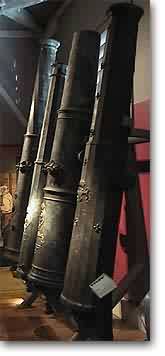Conservation of the Mary Rose bronze guns
The bronze guns
If the gun was loaded, the tampion, wad (unpicked rope or hay), shot, more hay and gunpowder were removed. Electrolysis was then carried out in the bore using sodium hydroxide or a mixture of sodium hydroxide/sodium sesquicarbonate electrolyte. One bore was chemically stripped using an EDTA solution. The bores were then washed with changes of deionised water and a benzotriazole (BTA) solution in water added before being dried with acetone. The exteriors were mechanically cleaned of concretions and loose surface corrosion using hand tools and glass bristle brushes. The surface was degreased with swabs of acetone, then swabbed with benzotriazole solution in Industrial Methylated Spirits and then lacquered with Incralac in acetone. The surface was then coated with a microcrystaline wax (Renaissance wax) which was also used to fill damaged areas. Although this was done some 20 years ago, I'm not sure I would do much different today. I am not a big fan of electrolysis or chemical cleaning as it removes evidence and may lead to further corrosion if the chemicals are not fully washed out, but if corrosion does occur within the bore, you may not be aware of it for some time. BTA is not infallible and some copper alloys may continue to corrode after treatment. It may be better to hydrolyse unstable chlorides before using this treatment, but some of these treatments may change the corrosion. I have heard that Bob Smith in the Royal Armouries in Leeds, UK has been using hot washing as a treatment on guns. I don't know what he does, but this may hydrolyse the chlorides. About iron gunsAs for iron guns, I am not happy with the treatment of the Mary Rose iron guns, which was hydrogen reduction. The North and Pearson book gives a good review of iron treatments, but no treatment will stabilise iron and they must be kept in a controlled atmosphere to ensure that further corrosion does not occur. Bob Smith also wrote a very good article on the treatment of the Commonwealth gun at the Royal Armouries using alkaline sulphite in the IJNA a few years ago. Martin Read Related links
ReferenceNorth, N. A., and C. Pearson. 1975a. Investigation Into Methods for Conserving Iron Relics Recovered from the Sea. In Conservation in Archaeology and the Applied Arts. IIC, London. Pearson, C. (ed.) 1987 Conservation of Marine Archaeological Objects, Butterworths, London. |

 Back to Nordic Underwater Archaeology
Back to Nordic Underwater Archaeology